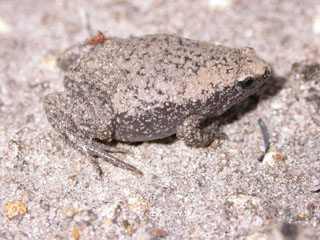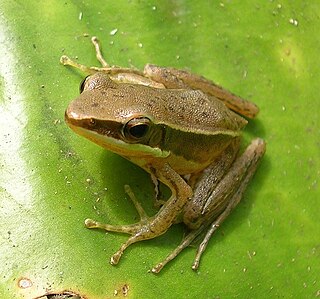
Oryza is a genus of plants in the grass family. It includes the major food crop rice. Members of the genus grow as tall, wetland grasses, growing to 1–2 m tall; the genus includes both annual and perennial species.

The Megophryidae are a large family of frogs native to the warm southeast of Asia, from the Himalayan foothills eastwards, south to Indonesia and the Greater Sunda Islands in Maritime Southeast Asia, and extending to the Philippines. As of 2014 it encompasses 180 species of frogs divided between 9 genera. For lack of a better vernacular name, they are commonly called megophryids.

The Hyperoliidae, sedge and bush frogs, are a large family of small to medium-sized, brightly colored frogs which contains more than 250 species in 19 genera. Seventeen genera are native to sub-Saharan Africa. In addition, the monotypic genus Tachycnemis occurs on the Seychelles Islands, and the genus Heterixalus is endemic to Madagascar.

The Hylidae are a wide-ranging family of frogs commonly referred to as "tree frogs and their allies". However, the hylids include a diversity of frog species, many of which do not live in trees, but are terrestrial or semiaquatic.

The Microhylidae, commonly known as narrow-mouthed frogs, are a geographically widespread family of frogs. The 584 species are in 61 genera and 11 subfamilies, which is the largest number of genera of any frog family.

Chiromantis is a genus of frogs in the family Rhacophoridae. It contains species from the Sub-Saharan African tropics as well as from South and East Asia. The Asian species were formerly assigned to Chirixalus, but this taxon was shown to be paraphyletic with respect to African Chiromantis. Consequently, Chirixalus were included in Chiromantis. Monophyly of Chiromantis also required erecting a new genus Feihyla for "Chirixalus palpebralis".
Bullfrog is a common English language term to refer to large, aggressive frogs, regardless of species.

Tagiades, commonly known as snow flats, is a genus of spread-winged skipper butterflies. It is the type genus of the tribe Tagiadini of the subfamily Pyrginae in the family Hesperiidae. It contains seventeen species; three of which are found in tropical Africa, while fourteen are found from India, Sri Lanka, Southeast Asia, northeast Australia, to the Pacific Islands. They are primarily diurnal butterflies, and can usually be found in secondary forests at up to 1,300 m (4,300 ft) above sea level. They can sometimes be encountered in partially cleared or cultivated areas. They are fast flyers, flying at an average height of 2 to 6 m. They usually rest on the undersides of leaves. When disturbed they will fly away but will usually return to the preferred area, often to the same leaf.

Arthroleptis wahlbergii, the bush squeaker, is a species of frog in the family Arthroleptidae. It is found along the coastal areas of eastern South Africa and possibly Mozambique.

Cornufer heffernani, sometimes known as the Solomon Island palm frog, is a species of frog in the family Ceratobatrachidae. It is endemic to the Solomon Islands archipelago where it can be found in at least Buka and Bougainville Islands of Papua New Guinea and Choiseul and Santa Isabel Islands of the Solomon Islands, but probably also more widely. The specific name heffernani honours Mr. N. S. Heffernan, who collected the type series.

The common green frog is a frog species of in the true frog family Ranidae; some sources still use the old name Rana erythraea. It lives in Southeast Asia and is also known as green paddy frog, red-eared frog or leaf frog. The last name, however, commonly refers to the Neotropical tree frogs which make up the subfamily Phyllomedusinae. These are not closely related to H. erythraea, belonging to family Hylidae instead.

A tree frog is any species of frog that spends a major portion of its lifespan in trees, known as an arboreal state. Several lineages of frogs among the Neobatrachia have given rise to tree frogs, although they are not closely related to each other.

Microhyla fissipes is a microhylid frog from East and Southeast Asia, from southern and central China and Taiwan to the Malay Peninsula. It was previously considered to be the same species as Microhyla ornata of South Asia; thus the common names ornate narrow-mouthed frog or ornamented pygmy frog can refer to either species.

Pepes is an Indonesian cooking method using banana leaf as food wrappings. The banana-leaf package containing food is secured with lidi seumat, and then steamed or grilled on charcoal. This cooking technique allows the rich spice mixture to be compressed against the main ingredients inside the individual banana leaf package while being cooked, and also adds a distinct aroma of cooked or burned banana leaf. Although being cooked simultaneously with food, the banana leaf is a non-edible material and is discarded after cooking.

Hylarana, commonly known as golden-backed frogs, is a widespread genus of true frogs found in tropical Africa, Asia, and Australia. It includes around 84 to 96 valid species.

The Ranoidea are a superfamily of frogs in the order Anura. Members of this superfamily are characterised by having the pectoral girdle fused into a single complex unit, having no ribs, and using an axillary grip during amplexus. The larvae have a single spiracle on the left side and complex mouthparts, or in some species, undergo direct development.
The marbled frog is a species of ground-dwelling frog in the family Myobatrachidae native to northern and north-eastern Australia, and southern New Guinea.
Banded frog may refer to:














